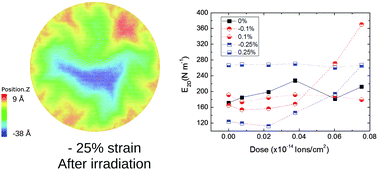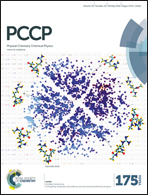Controlled rippling of graphene via irradiation and applied strain modify its mechanical properties: a nanoindentation simulation study†
Abstract
Ripples present in free standing graphene have an important influence on the mechanical behavior of this two-dimensional material. In this study, we show through nanoindentation simulations, how out-of-plane displacements can be modified by strain, resulting in softening of the membrane under compression and stiffening under tension. Irradiation also induces changes in the mechanical properties of graphene. Interestingly, compressed samples, irradiated at low doses are stiffened by the irradiation, whereas the samples under tensile strain do not show significant changes in their mechanical properties. These simulations indicate that vacancies produced by the energetic ions cannot be the ones directly responsible for this behavior. However, changes in roughness induced by the momentum transferred from the energetic ions to the membrane, can explain these differences. These results provide an alternative explanation to recent experimental observations of the stiffening of graphene under low dose irradiation, as well as the paths to tailor the mechanical properties of this material via applied strain and irradiation.


 Please wait while we load your content...
Please wait while we load your content...